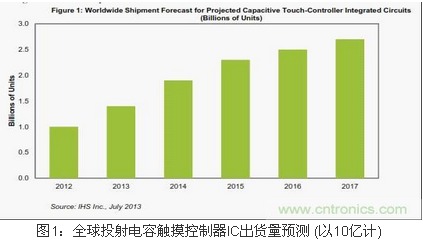 With the rapid start-up and expansion of smartphones and tablets, the market for projection capacitor (PCAP) touch controllers will certainly grow steadily this year and in the coming years. Since new applications such as laptops, ultrabooks, and ultra-thin PCs must also use PCAP touch controllers, the demand market is expected to continue expanding in the next few years.
With the rapid start-up and expansion of smartphones and tablets, the market for projection capacitor (PCAP) touch controllers will certainly grow steadily this year and in the coming years. Since new applications such as laptops, ultrabooks, and ultra-thin PCs must also use PCAP touch controllers, the demand market is expected to continue expanding in the next few years. IHS iSuppli expects total shipments of PCAP touch controller ICs to reach 1.4 billion units this year, up 40% from the 1 billion in 2012. The next two years will continue to grow at a strong double-digit rate, after which it will increase at a high single digit rate, at least until 2017. It is expected that the volume of shipments in 2017 will grow to around 2.7 billion. As shown in Figure 1, the five-year compound annual growth rate is equivalent to 21%.
The PCAP touch controller IC market continues to see strong growth through wireless products, especially mobile phones and tablets. Apple introduced the iPhone in 2007 and launched the iPad in 2010. It brings us today's familiar touch display and touch-centric user interface, and has created the PCAP touch controller IC market. Since then, touch products have been sought after by consumers because of their ease of use and sensitivity, and PCAP has also expanded into other products such as PC screens and car displays.
Even so, the adoption of other new markets will be critical to the continued growth of the industry. Although the wireless communication field will still be the largest application area of ​​touch controller ICs in terms of operating revenue, it will be far ahead, but its share of total PCAP operating revenue will decline year by year. In order to compensate for the relative decline in the wireless sector, other areas such as Superbooks need to come to the top - this situation is expected to happen, the PCAP semiconductor industry can maintain the momentum of expansion.
Ultrabook is the fastest growing application in the next 5 years
In the field of mobile phones, PCAP touch controller ICs are mainly used for smart phones or mobile phones with advanced operating systems. On average, each mobile phone has a touch IC. However, as the price of touch ICs continues to fall, these controllers will also become more involved in low-end handsets, namely feature phones.
Second only to smart phones, the media tablet is also an important area for the growth of the PCAP touch controller IC market. The number of touch ICs used in various media flat panels is different. The iPad usually uses more ICs, while the smaller size flat panel uses at least one touch controller. However, as small-sized tablet models are expected to increase, and with the development of touch IC technology, even if a large-size tablet uses less ICs in the future, it is sufficient to meet the requirements. Therefore, the average PCAP touch controller IC for each tablet will be used in the future. Will continue to decrease.
On the PC side, the ultrabook will be one of the fastest growing areas in the next five years. This is mainly because of Intel’s strong support, and Intel has put the touch function as the core of its super-base strategy. In addition to the Ultrabook, other products that will help boost the PCAP market include touchscreen-based integrated computers (AIOs) and PC tablets. .
Touch technology is also being adopted by other markets. PCAP will be increasingly used in LCD monitors and consumer electronics products such as digital cameras, digital video cameras, e-book readers, and portable game consoles.
The touch screen develops in the direction of IN-Cell
An important trend of touch screens is the use of in-cell LCD panels. By integrating the touch screen with the LCD panel, the touch screen can be made lighter and thinner. Apple introduced the technology in the iPhone 5 launched in the fourth quarter of 2012.
This trend will affect PCAP touch controller ICs, especially because it relates to display driver ICs that generate images on device displays. To achieve a smoother touch experience, two potential solutions may be employed: combining the display IC with the touch controller IC in a single package; or combining the two ICs on a single silicon chip.
Although modular solutions may save space and reduce overall system costs, product adoption will be slow. Even by 2016, touch products with a single-chip solution will be less than 20%. At present, most in-cell PCAP solutions will continue to be variants of a single package.
Brian O'Rourke, the author of this article, is a senior principal analyst of display electronics at IHS.
China ABC-â… â… Access Building Cable,Fibre To The House,Access Building Cable,Special Type Wiring,Psp Enhancing Moisture-Proof, Access Building Cable Manufacturers, China Indoor Access Building Cable
Shandong Qingguo Optical Fiber Co., Ltd. , https://www.qgfiber.com